|
||||||||||
|
|
||||||||||
|
||||||||||
|
|
||||||||||
The key to making a jet engine work is the compression of the incoming air. If uncompressed, the air-fuel mixture won't burn and the engine can't generate any thrust. Most members of the jet family employ a section of compressors, consisting of rotating blades, that slow the incoming air to create a high pressure. This compressed air is then forced into a combustion section where it is mixed with fuel and burned. As the high-pressure gases are exhausted, they are passed through a turbine section consisting of more rotating blades. In this region, the exhausting gases turn the turbine blades which are connected by a shaft to the compressor blades at the front of the engine. Thus, the exhaust turns the turbines which turn the compressors to bring in more air and keep the engine going. The combustion gases then continue to expand out through the nozzle creating a forward thrust. The above explanation describes a simple turbojet, as illustrated below.
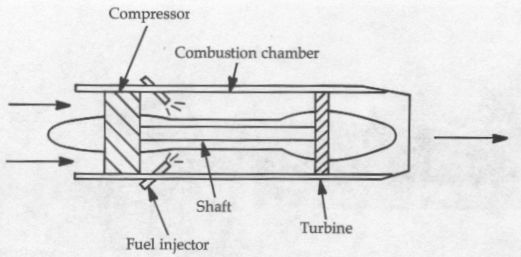
The turbojet (and the turbofan) can also be fitted with an afterburner. An afterburner is simply a long tube placed in between the turbine and the nozzle in which additional fuel is added and burned to provide a significant boost in thrust. However, afterburners greatly increase fuel consumption, so aircraft can only use them for brief periods.
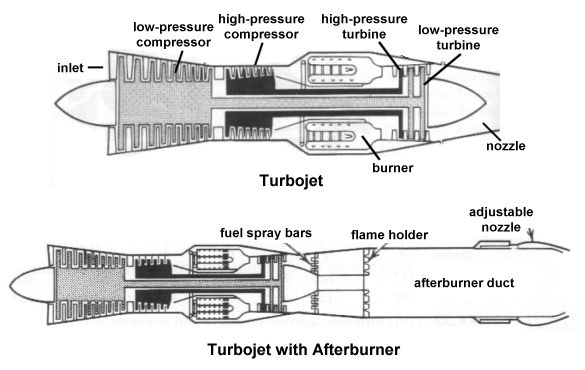
A further variation on the turbojet is the turbofan. Although most components remain the same, the turbofan introduces a fan section in front of the compressors. The fan, another rotating series of blades, is also driven by the turbine, but its primary purpose is to force a large volume of air through outer ducts that go around the engine core. Although this "bypassed" air flow travels at much lower speeds, the large mass of air that is accelerated by the fan produces a significant thrust (in addition to that created by the turbojet core) without burning any additional fuel. Thus, the turbofan is much more fuel efficient than the turbojet. In addition, the low-speed air helps to cushion the noise of the jet core making the engine much quieter.
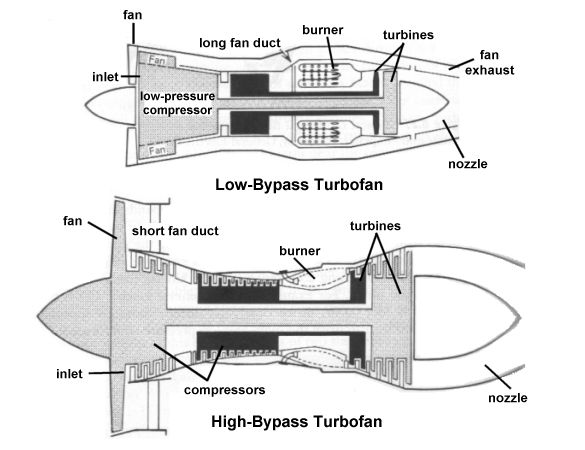
Turbofans are typically broken into one of two categories--low-bypass ratio and high-bypass ratio--as illustrated above. The bypass ratio refers to the ratio of incoming air that passes through the fan ducts compared to the incoming air passing through the jet core. In a low-bypass turbofan, only a small amount of air passes through the fan ducts and the fan is of very small diameter. The fan in a high-bypass turbofan is much larger to force a large volume of air through the ducts. The low-bypass turbofan is more compact, but the high-bypass turbofan can produce much greater thrust, is more fuel efficient, and is much quieter.
A concept similar to the turbofan is the turboprop. However, instead of the turbine driving a ducted fan, it drives a completely external propeller. Turboprops are commonly used on commuter aircraft and long-range planes that require great endurance like the P-3 Orion and Tu-95.
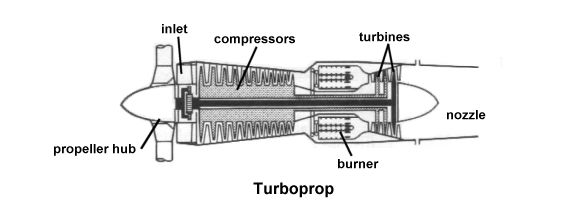
The turboprop is attractive in these applications because of its high fuel efficiency, even greater than the turbofan. However, the noise and vibration produced by the propeller is a significant drawback, and the turboprop is limited to subsonic flight only. In a typical turboprop, the jet core produces about 15% of the thrust while the propeller generates the remaining 85%.
Another noteworthy variation on the turbojet is the ramjet. The idea behind this type of engine is to remove all the rotary components of the engine (i.e. fans, compressors, and turbines) and allow the motion of the engine itself to compress incoming air for combustion.
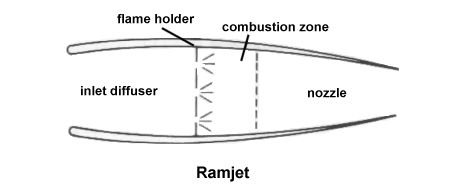
However, the price of this simplicity is that the ramjet can only produce thrust when it is already in motion. Instead of using a compressor to draw in air and compress it for combustion, the ramjet relies on the motion of the aircraft to ram air into the engine at high enough speed that it is already sufficiently compressed for combustion to occur. Since ramjets typically cannot function until reaching about 300 mph (485 km/h) at sea level, they have been rarely used on manned aircraft. However, the ramjet is more fuel efficient than turbojets or turbofans starting at about Mach 3 making them very attractive for use on missiles. Such missiles are typically launched using rocket motors that accelerate the vehicle to high-subsonic or low-supersonic speeds where the ramjet is engaged.
Finally, let us talk briefly about the turboshaft, a version of the jet engine that powers nearly every helicopter built today. As the below image illustrates, the turboshaft utilizes many of the same components as a turbojet.
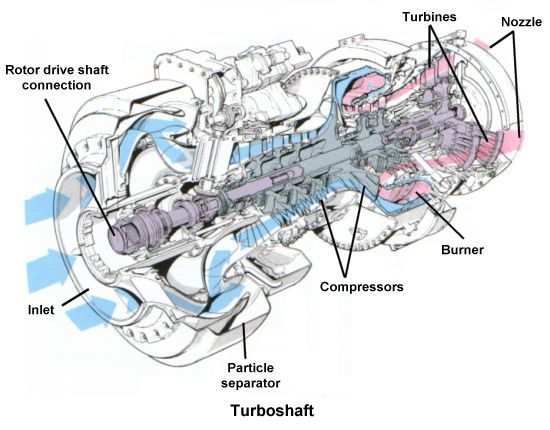
Air is drawn in through an inlet, compressed by low- and high-pressure compressor blades, mixed with fuel and burned in a combustion chamber, passed through turbine blades, and exhausted through a nozzle. The key difference between the turboshaft and previously discussed engines is that the turbine not only drives the compressors, but the shaft is also connected to a gear box that drives a helicopter's rotor blades. Although the engine shaft rotates about the horizontal, the gear box contains a sequence of gears that transform that motion to a rotation about the vertical axis as required by a helicopter main rotor. Helicopters also typically operate at much lower altitudes than aircraft where dust, sand, and other debris can easily be sucked into the engine. To address this problem, most turboshaft engines are equipped with a particle separator that filters out and expels the unwanted dust before the air flow reaches the compressor.
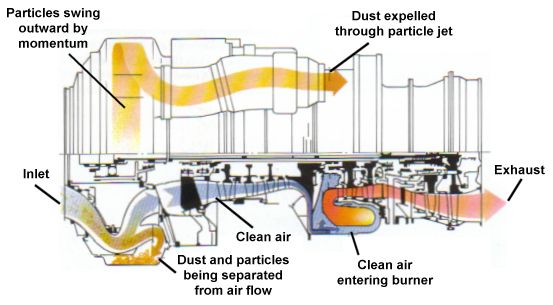
While the turboprop is still popular on aircraft where low fuel consumption is vital, nearly all aircraft today
employ some version of the turbofan, usually high-bypass turbofans. The high thrust, low fuel consumption, and
low noise levels of these engines make them well-suited to both military and commercial applications. Today, about
the only use for turbojets and ramjets is in missiles. Air-breathing, long-range, subsonic missiles like the
Tomahawk use turbojets since these are small, relatively low-cost systems that provide much greater range than
is possible with a rocket of comparable size. Ramjets find applications on air-breathing, long-range, supersonic
missiles for similar reasons. Turboshafts, of course, have displaced the piston engine as the primary powerplant
used on helicopters. To continue learning more about aircraft propulsion, be sure to check out NASA's
Learning Guide on Propulsion for
a wealth of information, animations, and interactive applets about rockets, propellers, ramjets, and gas turbine
engines.
- answer by Joe Yoon, 1 July 2001
Related Topics:
What is the difference between a jet engine and a rocket engine?
How do the J58 engines on the Blackbird change from normal jets to ramjets as the plane accelerates?
Why is hydrogen used as fuel in a scramjet engine?
Read More Articles:


|
Aircraft | Design | Ask Us | Shop | Search |

|
|
| About Us | Contact Us | Copyright © 1997- | |||
|
|
|||